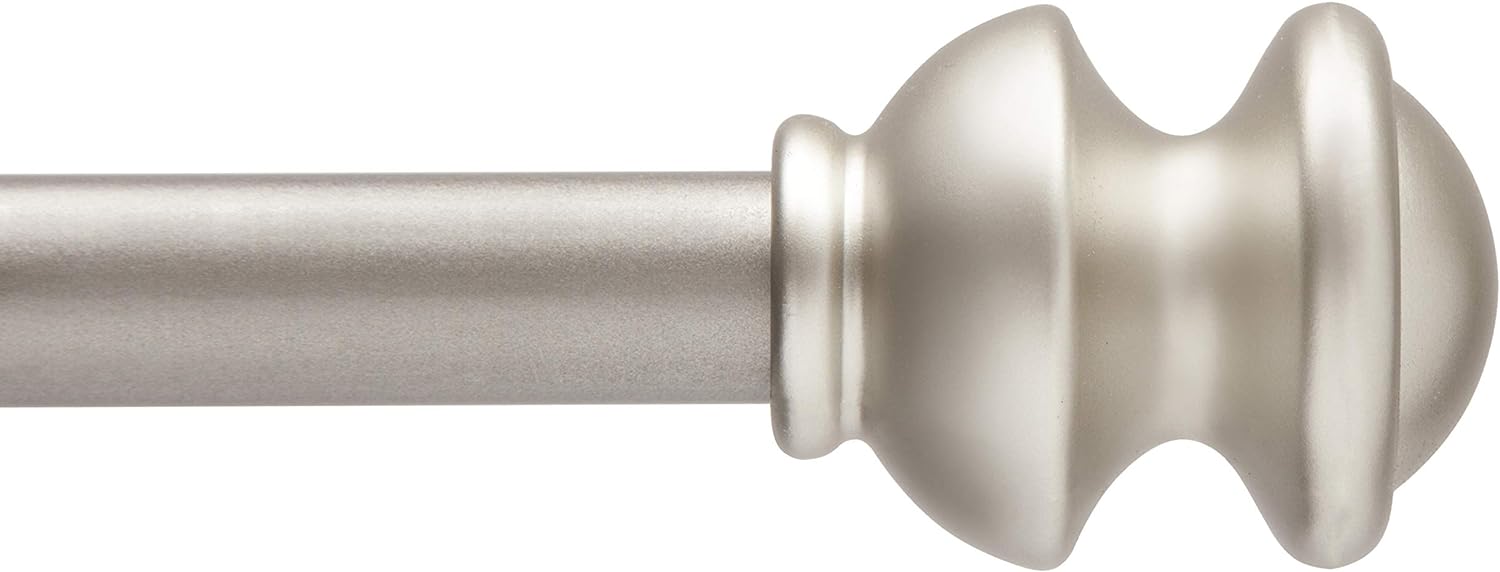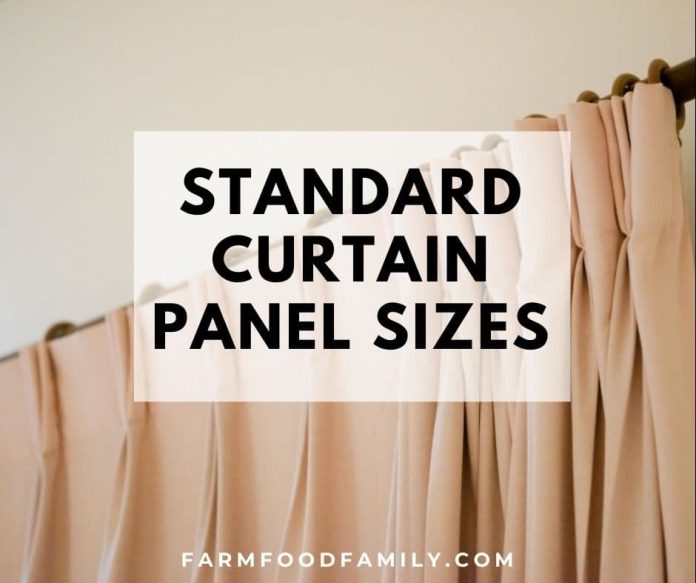Standard Curtain Panel Sizes: How To Choose The Right Lengths
Choosing curtains for your windows might look like a walk in the park but anyone who has done it themselves would find that sometimes the window size does not specifically meet standard curtain panel sizes. With this, you must take a deep breath and calculate in your head whether the nearest size would suffice for your windows’ dimensions.
To escape this task, you must understand how standard curtain panel sizes work. In this post, we will talk about that and more, so read on.
In this article:

What are the standard curtain panel sizes?

Curtains and draperies come in standard panel sizes. Just like in clothes, curtain panel sizes give a standard measurement of the curtain’s length. These sizes are strictly followed by architects and interior designers. The most common sizes would range from 63, 84, 95, 108 and 120. Width size can vary but the most common is at 45-inches. Usually, one curtain panel cannot cover a standard size window. Most of the time, the needed curtain panels would be two or more.
Standard curtain lengths
There are four standard lengths for curtains: 63, 84, 96 and 108 inches. These lengths are used for pre-made, mall ready curtains. They come in a range of styles and designs from sheer to blackout, fabric, etc.
If you have low ceilings, never opt for the 84inches. In most cases, the 96- and 108-inches curtain lengths are more versatile as they could be easily adjusted in any type of window.
Curtain length options
As have been mentioned, pre-made curtains come in lengths ranging from 63 to 108 inches. Some stores also have curtain length options of 120-144 inches. If you would ask about the best curtain length, there is no definite figure to answer that.
If you have standard size windows, you can easily choose curtain panels because all you have to do is get the measurement. Of course, if you have customized sizes, you will have to wait for a few more days for the tailor to adjust your curtain length in the specific measurements of your window.
Standard tier curtains

Click here to learn more this tier curtain on Amazon
Tier curtains are usually used for smaller windows that are not that emphasized or do not need that much covering. This type of curtain works a lot for windows above the kitchen sink because they are expected to just typically cover half of the window.
There are two standard lengths for tier curtains: 24 and 36 inches (plus the common window width of 45-inches. But like standard curtains, tier curtains could also be customized depending on your desired style and window dimensions.
Standard valance

Click here to check out this valance on Amazon
In contrast with tier curtains, valances are used to cover the top half of the window. It is installed when a full curtain setup is not needed such as in bay windows. It is also used to conceal privacy screens such as blinds, or shades.
When it comes to valances, the standard size would be 50-inches wide and at 3-5 inches deep. The depth depends on your window style as well as the design of your valance.
Standard curtain widths
In the US, the standard curtain width would be 54”. But generally, it ranges from 50-58”. Some curtain manufacturers even go for as long as 108”. Again, knowing the curtain width is as essential as the length because you have to align it with standard curtain sizes.
The standard size of curtain rod
Despite the variants of curtain rods available in the market, as a curtain accessory, it still follows standard sizes. Curtain rods come in 24-48, 48-84, 66-120, and 120-170 inches. While these sizes could suffice for most standard window sizes, there are also adjustable rods that were specifically designed for customized curtains.
What are the different types of curtain rods?
The type of curtain you are choosing is important in choosing the curtain rod that you should install. Here are the different types of curtain rods that you should check out:
- Caffe curtain rod: pocket style rods for sheer fabric curtains
- Traverse curtain rod: works for pinch pleated curtains; comes with regular and decorative variants
- I-Beam curtain rod: it is an aluminum rod for sheer fabrics and high ceilings
- Extendable iron rod: it will work with any kind of curtain and all window sizes
- Decorative iron rod: this one is usually installed at least 6” above the window frame; it is used for any type of curtain and draperies
- Wooden curtain rod: for classic style homes, this is the curtain rod for you; it will go for any kind of drapery or curtain
- Acrylic rod: for a minimalist, clean look, choose clear curtain rods; they are good for pleated curtains and brush nickel ring curtains
How to measure curtain rods?

Click here to check out this rod on Amazon
Measuring the curtain rods should not be difficult. First, you have to measure the dimensions of your window. Now, add 6” to each side to your measured dimensions. After that, mark your walls with pencil for greater accuracy once you hang the rods. After all of these, shop for your desired type of curtain rod. Follow the pencil marks and you are good to go.
What is the standard drop for curtains?
Even curtain drops follow standard lengths too. Curtain drops come in 54-, 72-, and 90-inch lengths. Some curtain manufacturers take into account larger windows, as such, extending their curtain drop length to 108-inches.
If you measure your curtain drop and it does not touch the floor the way you envisioned it too, you have to round it up to the nearest standard drop. So, for instance, you got the 58” and the result is awkward looking, you have to switch it up to 72-inches.
How to measure for curtain panels
If you want to make sure about the dimensions and want to measure the length by yourself, here is how to measure curtain panels:
- First, you must choose the spot where the curtain rods and other hardware will be installed. You can either go for outside mounting if you want the curtains to cling around the window. There is also an inside mounting so that the curtains would hang within the window’s opening.
- Now, measure your window’s width. The general rule of thumb is to always add 12-inches on all sides for more flexibility. This would also help you in determining how many curtain panels you should get. Typically, all you need are two panels but for a layered, bulkier effect, you can make it 4-6 panels.
- With the adjusted length, re-measure the dimensions. For example, if you have a 60-inches window, add the additional 24-inches to the figure. Now you get 84-inches. Divide it into 2 and you get 42-inches. That is the figure that you need to get.
- Now go for the length. Measure the chosen spot for the rod and run the measuring tape down its length or in the desired drop point.
- Get these two figures and have a splurge to your nearest tailor or fabric store.
How to read curtain sizes
Reading curtain sizes is very simple because the curtain measurements are already written in the decks where the fabrics are. Some stores even have them taped in the fabric themselves. So if you find a curtain that reads 46” x 54”, it means that the curtain is 46-inches in width and its drop would be 54-inches.
Knowing beforehand the figures that you are looking for helps you in aiming for the right curtain size immediately. Never buy bigger curtains just because you think you would save money in covering your windows. Always stick to the right curtain size.
Should curtains be longer than the window?
Yes. As a matter of fact, curtains are supposed to drop to the floor. And even if you are not hanging a floor-length curtain, the role of curtains is to cover the window and provide balanced insulation to the room. As such, they need to be longer than the window to do those functions that are expected of curtains to deliver.
Should bedroom curtains be long or short?

Interior designers universally agree that bedroom curtains should be long enough to touch or brush the floor but not long enough to create fabric puddling. If you are not sure about how long your bedroom curtain should be, you can choose from the following drop types:
- Small puddle (just 1-2 inches extension to the floor)
- Kiss length
- Floating length
Should curtains go to the floor?
As have been mentioned, interior designers agree that curtains should essentially drop to the floor. They can extend to have a little puddle but not long enough for the curtains to be dragged whenever you close or open the door. Above 3-inches is no longer a good puddle.
To learn more this, check out this article: Should Curtains Touch The Floor?
Are curtains sold in pairs?
The direct answer is not always. Most of the time, curtains are sold in pairs, but it is always possible to just buy a single panel especially for small windows like in the bathroom or kitchen.
Related: 26+ Beautiful Types of Kitchen Curtains and Valances (Modern, Luxury, and More)
Do curtains have to match in an open floor plan?
Yes. The balance of the room should be a priority and choosing curtains that match the patterns or the general vibe of the room is an important aspect of that balance. If you are not a fan of strict mix and match, at least create a cohesive pattern for the fabrics and curtains.
Should curtains be darker or lighter than walls?
The general rule of thumb in this is that your curtain should be one shade darker or lighter than your walls. This is an important information to add to the previous question.
Related: What Curtains Go With Gray Walls In Bedroom, Living Room?
Conclusion
There is more to curtain panel sizes that just reading measurements. There are a lot of factors and considerations to master. There are different kinds of curtain lengths and dimensions but there are also types of curtains and drop styles that you should choose alongside these. Aside from that, you also must know how to get the right measurements to get the perfect fit.
With all things considered, there is one important thing that should be remembered: when it comes to curtain panel sizes, from choice to measurement, to hanging it up, accuracy is key.

